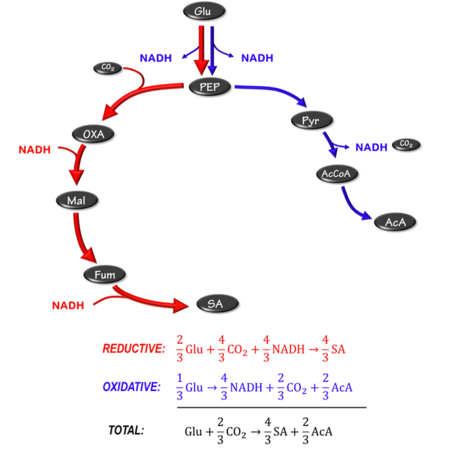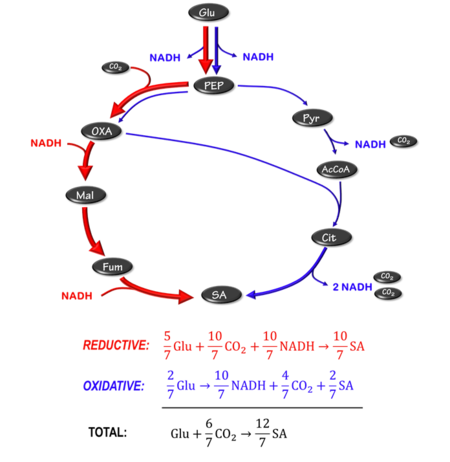Succinic acid fermentation
This article has multiple issues. Please help improve it or discuss these issues on the talk page. (Learn how and when to remove these template messages)
|
Microbial production of Succinic acid can be performed with wild bacteria like Actinobacillus succinogenes,[1] Mannheimia succiniciproducens and Anaerobiospirillum succiniciproducens or genetically modified Escherichia coli, Corynebacterium glutamicum and Saccharomyces cerevisiae. Understanding of the central carbon metabolism of these organisms is crucial in determining the maximum obtainable yield of succinic acid on the carbon source employed as substrate.
Metabolic pathways
Neglecting the carbon utilised for biomass formation (known to be a small fraction of the total carbon utilised) basic


The metabolic pathway can be genetically engineered in order to have succinic acid as the only excretion product.[3] This can be achieved by using the oxidative section of the tricarboxylic acid cycle (TCA) under anaerobic conditions as illustrated in Figure 3. Alternatively the glyoxylate bypass can be utilised (Figure 4) to give the same result. For both these scenarios the mass based succinic acid yield is 1.12 g/g. This implies that the theoretical maximum yield is such that more succinic acid is formed than glucose consumed due to the fixation of carbon dioxide.


References
- ^ van Heerden, C.D.; Nicol, W. (2013). "Continuous succinic acid fermentation by Actinobacillus succinogenes". Biochemical Engineering Journal, 73. See at publisher
- Environmental Microbiology, 71:11. See at publisher
- ^ van Heerden, C.D.; Nicol, W. (2013). “Continuous and batch cultures of Escherichia coli KJ134 for succinic acid fermentation: metabolic flux distributions and production characteristics”, Microbial Cell Factories, 12:80.See at publisher
